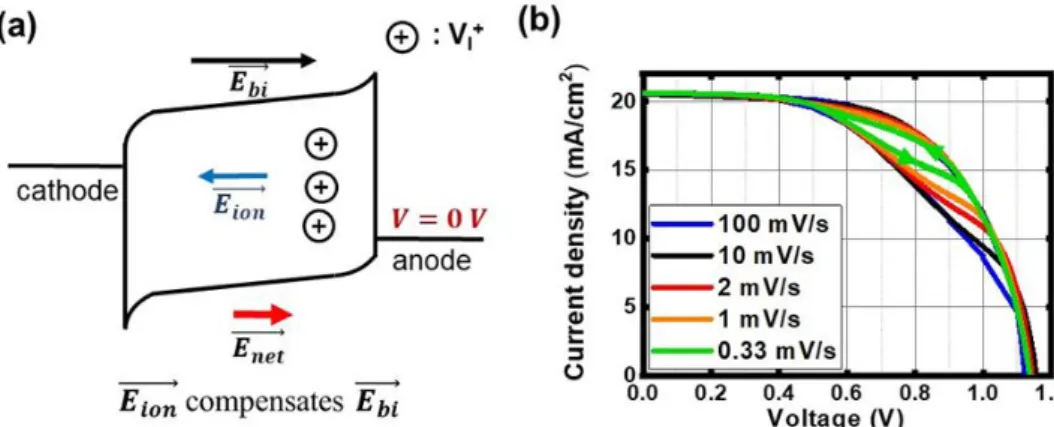HAL Id: cea-03123520
https://hal-cea.archives-ouvertes.fr/cea-03123520
Submitted on 28 Jan 2021HAL is a multi-disciplinary open access
archive for the deposit and dissemination of sci-entific research documents, whether they are pub-lished or not. The documents may come from teaching and research institutions in France or abroad, or from public or private research centers.
L’archive ouverte pluridisciplinaire HAL, est destinée au dépôt et à la diffusion de documents scientifiques de niveau recherche, publiés ou non, émanant des établissements d’enseignement et de recherche français ou étrangers, des laboratoires publics ou privés.
Modeling the perovskite solar cell and the ion migration
with physical approach based on FEM from Silvaco
Jihye Baik, Haeyon Jun, Hindia Nahdi, Bernard Geffroy, Denis Tondelier,
Yvan Bonnassieux
To cite this version:
Jihye Baik, Haeyon Jun, Hindia Nahdi, Bernard Geffroy, Denis Tondelier, et al.. Modeling the per-ovskite solar cell and the ion migration with physical approach based on FEM from Silvaco. Journées Nationales du Photovoltaïque, Jan 2021, Dourdan, France. 2021. �cea-03123520�
Modeling the perovskite solar cell and the ion migration
with physical approach based on FEM from Silvaco
Jihye Baik1, Haeyeon Jun1,2, Hindia Nahdi1,3, Bernard Geffroy1,4, Denis Tondlier1 and Yvan Bonnassieux1
1LPICM-CNRS (UMR7647), Ecole Polytechnique, IP Paris, 91128 Palaiseau, France
2Synchrotron SOLEIL, L'Orme des Merisiers Saint-Aubin, BP 48 91192 Gif-sur-Yvette Cedex, France 3SEGULA Technologies, 19 Rue d'Arras, 92000 Nanterre, France
4Université Paris-Saclay, CEA, CNRS, NIMBE, LICSEN, 91191 Gif-sur-Yvette, France
The hybrid perovskites have emerged as the promising alternative materials of silicon-based solar cells in PV industry due to high absorption coefficient [1] and long carrier lifetimes and diffusion lengths [2]. Even though the power conversion efficiency of perovskite solar cells (PSCs) has increased rapidly to 25.2 % in 2020 [3], PSCs have still drawbacks such as J-V hysteresis of which origins are not fully understood yet but might be ion migration [4], [5]. Therefore, studying factors causing J-V hysteresis is required to develop strategies for resolving the issue.
In this work, modeling of ion migration in the PSCs with physical approach based on finite element method is studied. As the time-transient state is necessary to investigate the hysteresis, the simulation is performed in time-transient state by using Atlas, Silvaco. The ion migration in methylammonium lead halide perovskite (CH3NH3PbI3) is described by drift-diffusion model. The ion
migration and accumulation induce the electric field compensation and result in the J-V hysteresis. We examined the J-V hysteresis dependent on various factors: ion diffusion coefficient, preset voltage time, and voltage scan rate.
Figure 1. (a) A scheme of PSCs with the compensation of built-in electric field due to the ion migration. The cations represent
the iodine vacancies and they transport to the anode side due to the built-in electric field. (b) The J-V hysteresis dependent on the voltage scan rate.
Keywords
Lead halide perovskite, Simulation, Silvaco, Ion migration, Drift-diffusion model
Reference
[1] B. Lei et al., “High-performance CH3NH3PbI3 perovskite solar cells fabricated under ambient conditions with high relative humidity”, Jpn. J. Appl. Phys., vol. 54, no. 10, 2015.
[2] B. Yu et al., “Charge carrier lifetimes exceeding 15 μs in methylammonium lead iodide single crystals”, J. Phys. Chem., vol. 7, no. 5, 2016.
[3] “NREL efficiency chart.” [Online]. Available: https://www.nrel.gov/pv/cell-efficiency.html.
[4] M. Grätzel et al., “Understanding the rate-dependent J-V hysteresis, slow time component, and aging in CH3NH3PbI3 perovskite solar cells: The role of a compensated electric field”, Energy Environ. Sci., vol.
8, no. 3, 2015.
[5] Y. Zhao et al., “Anomalously large interface charge in polarity-switchable photovoltaic devices: An indication of mobile ions in organic-inorganic halide perovskites,”, Energy Environ. Sci., vol. 8, no. 4, 2015.
